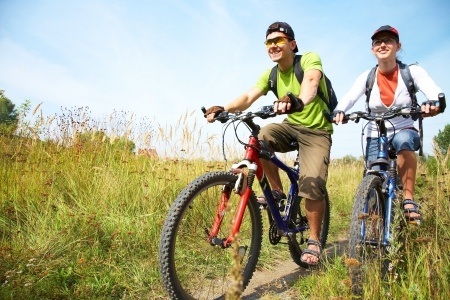
Cross training is an exercise tool, that when applied properly can increase strength and decrease the risk of injury simultaneously. Just like a proper warm-up. Encourage your personal training clients to cross-train.
Let clients know that cross training is a fancy way of saying to use the body in a different way than usual. It’s like taking a different route to work or trying a new recipe.
There are a couple basic concepts to understand when considering how to program cross-training for a particular sport like hiking or biking.
Cross-train In The Other Planes of Motion
Both hiking and biking exercise the body in the sagittal plane as opposed to tennis or baseball, which work the body in the transverse plane. The sagittal plane describes the joints of the body moving in flexion and extension, whereas transverse plane describes the joints of the body moving in rotation.
Bicycle wheels move in the sagittal plane and when humans want to travel forward they do as well. Transverse plane motion is also happening, but very subtly. There is a third type of motion called frontal plane motion, which is the way a crab moves – sideways. If you watch people move during various sports you can see that the body moves in different ways.
Realize, there are infinite planes of motion in the body – but there are the basic three to know about.
Lost in the Planes?
What’s more important to know then planes of motion is that when hiking and biking, the body is moving in a repetitive motion. The hips flex and extend repeatedly. In biking, the spine is flexed. Looking at these repetitive motions closely and imagining what it’s like for the body can help you make better choices of what to recommend for clients when not hiking and biking.
Strength Cross-training Exercises
Being mindful of what your clients are doing outside sessions with you helps you plan what to do when you are together. Weights and cables facilitate control of movement and target the motions not being used as much when hiking and biking.
When hiking and biking, the hips flex more than they extend, so doing bridges, deadlifts and donkey kicks are beneficial to work the other side of the joint. Side band walks work the hips in the frontal plane. A cable or machine can be used to do torso rotations in the transverse plane.
- Bridges. Lie on your back with knees bent and feet firm on the floor. Relax head, neck and shoulders. Lift hips up until in line with knees and hold for 15-20 seconds.
- Deadlifts. Standing with knees slightly bent and a straight back, hinge at hips slowly with light weights in hands. Feel a deep stretch in the hamstrings and glutes. Don’t go too far. Slowly stand back up tall and squeeze the muscles on the back of legs with core engaged.
- Donkey Kicks. Get on all fours with hands shoulder width apart and knees hip width apart. Extend one leg out slowly until it’s straight. Avoid arching lower back. Engage gluteus muscles.
- Side Band Walks. Place a resistance band or loop around ankles. Keep toes pointing forward while walking sideways. Go slow through the motion. Travel 10-15 steps and then switch directions.
- Torso Rotations. Hold a cable or resistance band in hands and imagine it’s a tennis racket or baseball bat. Slowly rotate body to work oblique abdominal muscles. Keep feet hip width apart and change body angle to the cable/band until a resistive place is found.
Perform these exercises with clients for 10-15 repetitions each or 45 second holds in a circuit that is repeated 1-3 times. Have them perform one cross-training cardio session for every 2-3 hikes or bike rides they go on. You could even teach them to do this routine on their own if it suits your big picture gameplan with them.
Cardio Cross-training Exercises
When your clients are not with you, suggest swimming or playing tennis as alternative cardiovascular exercises to incorporate transverse plane motion. This will give your clients a break from the sagittal plane motion of hiking and biking, but still get them cardio similar to on the trail.
Keep your clients active and injury free this summer by guiding them toward a well-rounded fitness program. Your client’s joints and body will thank you.
[info type=”facebook”]Join the Facebook Community Group to meet other trainers.[/info]



